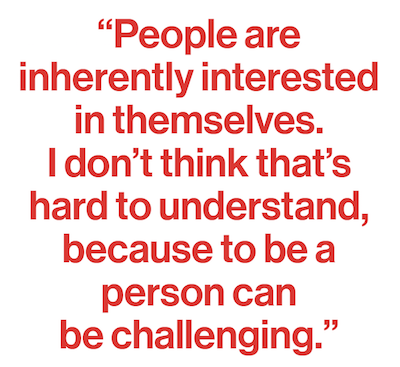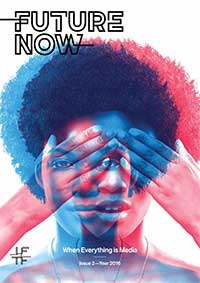Future Now
The IFTF Blog
The Evolution of the Quantified Self
A Conversation With Self-Tracking Pioneer Gary Wolf
Interview by Brad Kreit
In 2007, journalist Gary Wolf launched Quantified Self, a blog and meet-up group dedicated to what was then a niche phenomenon: people meticulously tracking personal metrics. Motivations were diverse: fitness freaks looking for ways to optimize their workout sessions, data-geeks in search of personalized productivity tricks, and patients with rare conditions who just couldn’t get clear answers about what was happening to their bodies. But these people had a common belief that they could find themselves in their data—and they were willing to put significant time and effort into capturing, storing and analyzing that information. Today, it’s not nearly as much work. Most new smartphones come with self-tracking capabilities that simply need to be switched on. And even dedicated fitness trackers are widely available at big box retail stores.
Future Now connected with Wolf to get the self-tracking pioneer and longtime Wired contributing editor’s perspective on how this phenomenon has evolved over the last decade and where it might go in the decade ahead.
Since you last spoke with IFTF seven years ago, Quantified Self activities have become much more common. Why do you think that is?
People are inherently interested in themselves. I don’t think that’s hard to understand, because to be a person can be challenging.
No one gets through life without having some challenge that makes you want to try really hard to understand yourself better. Especially if the normal “recipes” for how you take care of your health or accomplish any other goal don’t work for you. Maybe the first thing you do is talk to a doctor and they give you a standard “recipe” and you give it a try. What happens when that doesn’t work? You have to start thinking and investigating and reflecting. Now that the tools to do that in a more quantified way are getting easier to use, it doesn’t require as much hobbyist or vocational interest as it once did.
Other than broadening the appeal of self-tracking, what else changes when tools require much less active engagement to use?
We’ve come to recognize that active, intentional tracking is at least as important as passive tracking and maybe more important.
At the beginning, there were a lot of people working on passive tracking, asking, “how can we make tracking disappear in the background?” And just have the app tell you what it learns. I think the focus of Quantified Self has become very much, “Wait a second, your consciousness is part of this system—the most important part, actually.” We need to shift to focus on how technology can support our thinking about our behavior or our physiology, rather than how technology can function as an independent system that just tells us what’s going on.
 It turns out that a critical part of a Quantified Self project is deciding what you measure. It often takes people several tries to find a metric that really gets them closer to what they’re trying to discover. It’s a process of formulating a better question. It’s not just, say, doctors that have trouble understanding what it is that you care about. We sometimes have trouble understanding ourselves.
It turns out that a critical part of a Quantified Self project is deciding what you measure. It often takes people several tries to find a metric that really gets them closer to what they’re trying to discover. It’s a process of formulating a better question. It’s not just, say, doctors that have trouble understanding what it is that you care about. We sometimes have trouble understanding ourselves.
What about technologies that are just emerging today, digital assistants like Siri and Echo? Will they have an impact on the Quantified Self world?
They’re really important, but I think that the value of voice recognition and the machine learning systems that are behind them is the deep technical infrastructure, not the ability to have a fantasy virtual assistant. What I mean is that a lot of the benefits won’t necessarily feel like science fiction, but will still be really deep and profound.
I’ve had an idea for a self-tracking project which involves asking myself how I feel and, instead of using terms like happy and sad, trying to come up with other words. It’s like a vocabulary project. It’s really hard to do that because you have to say a word and then write it down and then put it into a spreadsheet and ask, “have I ever used that word before and how many times?” All that stuff is way too hard.
There’s thousands, tens of thousands, millions of ideas that will become reality when things like voice recognition and all of its associated machine intelligence become more acceptable to us.
When you look out 10 years, how digitally mediated do you think activities like reflection will be for most people? What might it look like to feel or reflect in 2026?
I think it’s going to be both more and less different than is commonly expected. It’s going to be more different in that it is hard to be appropriately mentally prepared for how thorough our integration with digital technologies is going to be. In that sense, it really will be like science fiction.
However, it’s going to be less different than expected in the sense that our consciousness and our subjectivity is still going to be the most important part of this system. That consciousness or subjectivity is a socio-biological element of this system that has its own pace and style of development. We’ll have a lot more tools and we’ll be using them way more than we can even imagine today. But the kinds of things we’re going to be asking of them, the reasons that we’ll be using them will be quite similar to the reasons we use our tools now.
 FUTURE NOW—When Everything is Media
FUTURE NOW—When Everything is Media
In this second volume of Future Now, IFTF's print magazine, we explore the future of communications. In our research process, we traced historical technology shifts through the present and focused on the question, “what is beyond social media?”
Think of Future Now as a book of provocations; it reflects the curiosity and diversity of futures thinking across IFTF and our network of collaborators. It contains expert interviews, profiles and analyses of what today’s technologies tell us about the next decade, as well as comics and science fiction stories that help us imagine what 2026 (and beyond) might look and feel like.
For More Information
For more information on IFTF's Future 50 Partnership and Tech Futures Lab, contact:
Sean Ness | sness@iftf.org | 650.233.9517



